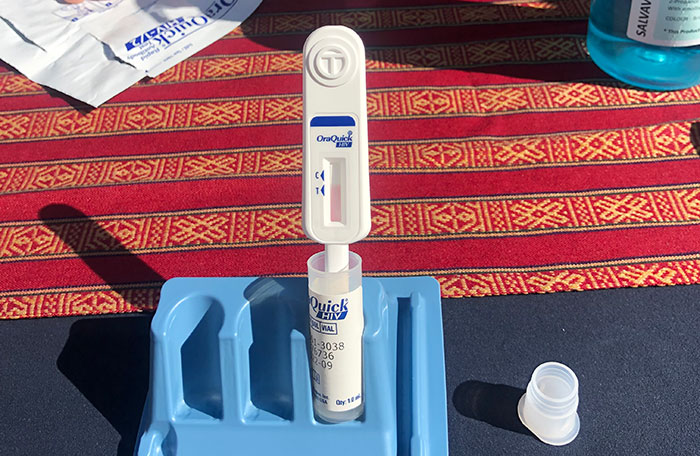
The HIV self testing kit
To promote testing and address confidentiality issues, HIV self-test kit introduced
Younten Tshedup
For many, an HIV diagnosis in the early 2000s was like a death sentence. If not from the disease, the extreme stigma and psychological trauma an individual faced, was almost homicidal.
But many, like Sital Chhetri, survived longer than anyone expected. He has been living with the virus for almost 15 years.
It was in 2006 the 46-year-old vividly recalls: “I had gone to the hospital to donate blood to my friend’s wife who was seriously ill.”
After the donation, Sital Chhetri received a call from the hospital in the evening. He was asked to return to the hospital.
“When the doctor told me I had HIV, my whole world came crashing down. The thought of breaking the news to my wife and children haunted me,” said the father of three. He took a retest. The results didn’t change.
For a few days, Chhetri said he could not share the news with his family. “After gathering enough courage, I told my wife and asked her that we should get a divorce.” Much to his surprise, his wife was very supportive and assured him that they would handle the situation together.
Slowly, words started spreading in the village. People ignored him and his family. “They started to call me AIDS man. They began ignoring me. My children’s friends in school teased them and they came home crying everyday. It was a tough time.”
Depressed and dejected, Chhetri resorted to drinking. “I forgot all the counselling I received from doctors. I would barely sleep, and the immediate thing I would do after I woke up was to drink.”
However, with support from his wife, Chhetri decided to fight the stigma along with the disease. “I realised I was no different than anyone in our village. I had good food to eat, warm shelter and above all, a supportive wife and family. I could not allow this disease to hold me back.”
He said that the decision he took that day had changed his entire life. “Despite having the disease, I’m happy today. Things are much different now, and our community has grown acceptable to our kind.”
Knowing one’s HIV status is imperative, says Sital Chhetri. “Even if you are negative, get yourself tested. If you have the disease, it is not an end. There are effective treatments which allow you to live longer and healthier. Hiding and living in a dilemma will get you nowhere.”
Bridging the gap
Bhutan today has an HIV detection gap of 43 percent. Since the first HIV positive case in 1993, the health ministry has so far diagnosed 741 HIV cases. As per the UNAIDS estimate, the country has around 1,300 positive cases of which 599 cases are unidentified for now.
In an effort to bridge the detection gap, the health ministry launched the HIV Self-Testing (HIVST) initiative, coinciding with the World AIDS Day, yesterday. The HIVST initiative includes a rapid test kit, similar to that of a pregnancy test kit, that uses oral swabs to detect the antibody produced in a person.
Health Minister Dechen Wangmo, during the launch, said that the self-testing initiative was launched to empower individuals and give them an opportunity to conduct their own test, at the comfort of their own home and privacy.
“This is an additional means of complementing our existing HIV testing mechanism, which is made available across all health centres, till the BHU level,” she said.
Chief of communicable disease division, Rixin Jamtsho, attributed the widening detection gap to social stigma and discrimination. The self-testing initiative is expected to ensure confidentiality.
Lyonpo said that besides stigmatisation in the community, certain levels of stigma against people living with HIV still existed even in the health care system. Although major improvements were observed over the years, the minister said that there was still room for improvement.
Inadequate public literacy and awareness of HIV/AIDS was also a major cause for the growing detection gap. Lyonpo said that besides awareness, it was important to disseminate comprehensive knowledge on HIV to the public.
“Besides preventive knowledge, to empower the people, it is also important to make services and commodities readily available for the public,” Lyonpo said. “The numbers currently are not much but it has a huge potential to grow, if not addressed.”
As of November this year, 54 new cases were detected; one each a week on average.
The country aspires to eliminate mother to child transmission (MTCT) of HIV, hepatitis and syphilis in 2023.
Lyonpo said that all pregnant mothers must avail the HIV testing services in order to save their babies. “For a population of about 700,000 people with around 11,000 live birth in a year, to have a child born with HIV is absolutely unacceptable.”
With no MTCT cases detected this year, Lyonpo said that it was a positive sign. “We’ve come a long way, in terms of having systems in place and enhancing testing. Now we’re using innovation to provide people-centric care.”
The country also plans to achieve the 90-100-90 goal by 2025.
Rixin Jamtsho said that in the next five years, 90 percent of the people with HIV will have to be detected, 100 percent of the diagnosed cases will have to be put under treatment and 90 percent of the diagnosed HIV cases will have to be put under viral suppression.

